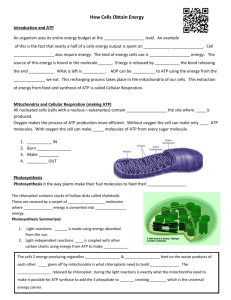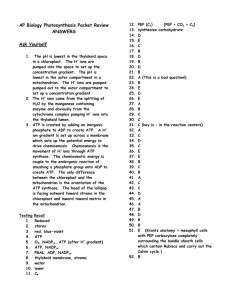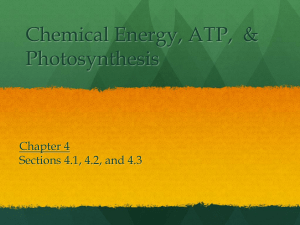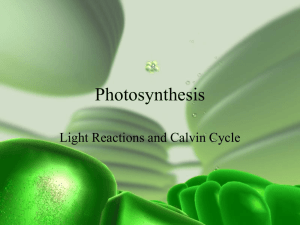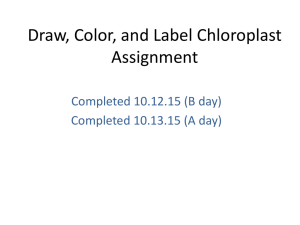Matter Cycles & Energy Transfer
advertisement
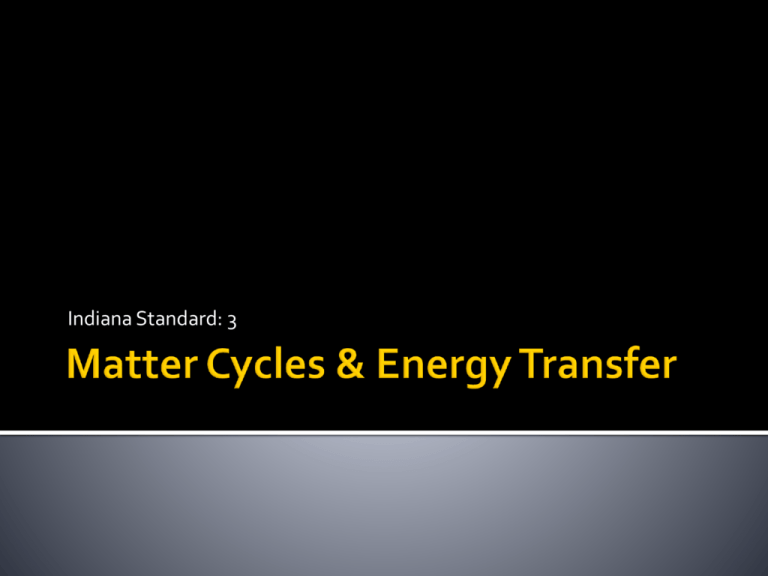
Indiana Standard: 3 Summary of Unit Energy is required by all living things. When you consume food, that food is broken down and used to produce energy. Your body uses energy to maintain homeostasis, for motion, for cell repair, and many other tasks. Much of the energy consumed by organisms is released into the atmosphere as heat. Energy can’t be created or destroyed - just converted from one form to another. Sum of all Chemical Reactions Within an Organism Catabolism • The breakdown of molecules (degradation) • Releases energy (ATP) Anabolism • Building of molecules (synthesis) • Uses energy (results in ADP) Chemical Energy ATP and ADP ATP = Adenosine Triphosphate ADP = Adenosine Diphosphate Photosynthetic Organisms = Producers Photosynthetic organisms produce their own sources of chemical energy. Photosynthetic Organisms = Producers • • • Sunlight is absorbed through chlorophyll Carbon dioxide enters through the stomata. Water enters through the roots Takes place in the Chloroplast Takes place in the Chloroplast Thylakoids • Have membranes that contain chlorophyll Stroma • Fluid inside the chloroplast Takes place in the Chloroplast Light Dependent Reactions • Happen in the thylakoids membranes, called the Electron Transport Chain • Chlorophyll absorbs energy from sunlight which excites the electrons • Water molecules are split into oxygen and hydrogen • Oxygen is released • ATP and NADH are produced and travel to the stroma to energize the Calvin Cycle Takes place in the Chloroplast Light Independent Reactions • Happen in the stroma in a process called the “Calvin Cycle” • Carbon dioxide and energy from the lightdependent reaction are used to build glucose (a sugar). Equation Takes place in the Chloroplast Takes place in the Chloroplast Thylakoids Takes place in the Chloroplast Stroma Thylakoids Takes place in the Chloroplast Sun Stroma Thylakoids Takes place in the Chloroplast Sun Water Stroma Thylakoids Takes place in the Chloroplast Sun Water Stroma Thylakoids Oxygen Takes place in the Chloroplast Sun Water Energy ATP Stroma Thylakoids Oxygen Takes place in the Chloroplast Sun Carbon dioxide Water Energy ATP Stroma Thylakoids Oxygen Takes place in the Chloroplast Sun Carbon dioxide Water Energy ATP Stroma Thylakoids Oxygen Calvin Cycle Takes place in the Chloroplast Sun Carbon dioxide Water Energy ATP Stroma Thylakoids ADP Oxygen Calvin Cycle Takes place in the Chloroplast Sun Carbon dioxide Water Energy ATP Stroma Thylakoids Calvin Cycle ADP Oxygen Glucose (sugar) Makes ATP by Breaking Down Sugar Cellular respiration makes ATP by breaking down sugars. Makes ATP by Breaking Down Sugar Glycolysis • Breaks 6 carbon glucose molecules down into two 3 carbon molecules called “Pyruvate” • Produces 2 ATP • Produces 2 NADH (energy carriers) Makes ATP by Breaking Down Sugar Glycolysis • Breaks 6 carbon glucose molecules down into two 3 carbon molecules called “Pyruvate” • Produces 2 ATP Anaerobic Process • Produces 2 NADH No Oxygen Required (energy carriers) Takes Place in the Mitochondrion Stage One: Krebs Cycle Stage One: Krebs Cycle • • • • Happens in the “Matrix” Glucose enters the Matrix Krebs Cycle begins Small amount of ATP is produced • Carbon dioxide is released as waste Stage Two Stage Two: Electron Transport • Happens in the Cristae • Oxygen enters the Cristae • Energy is moved through a chain of proteins • A large number of ATP molecules are made - 38! • Water is released as waste Equation Takes Place In the Mitochondrion Takes Place In the Mitochondrion Aerobic - Requires Oxygen Takes Place In the Mitochondrion Krebs Cycle in Matrix Electron Transport Chain in Cristae Takes Place In the Mitochondrion 2 three carbon glucose molecules called “Pyruvate” Krebs Cycle in Matrix Electron Transport Chain in Cristae Takes Place In the Mitochondrion 2 three carbon glucose molecules called “Pyruvate” Krebs Cycle in Matrix NADH Electron Transport Chain in Cristae ATP carbon dioxide Takes Place In the Mitochondrion 2 three carbon glucose molecules called “Pyruvate” Krebs Cycle in Matrix NADH ATP from Glycolysis Electron Transport Chain in Cristae oxygen ATP carbon dioxide Takes Place In the Mitochondrion 2 three carbon glucose molecules called “Pyruvate” Krebs Cycle in Matrix ATP carbon dioxide NADH ATP ATP from Glycolysis Electron Transport Chain in Cristae oxygen water Indiana Department of Education. (2010). Standards. Retrieved from Indiana Department of Education: http://www.doe.in.gov/sites/default/files/standards/science/2010-ScienceBiologyI.pdf Stephen Norwicki, P. (2012). Biology. Orlando, Florida: Houghton Miller Harcourt Publishing Company.
